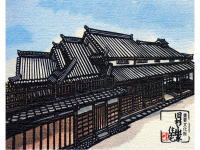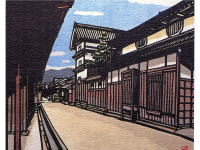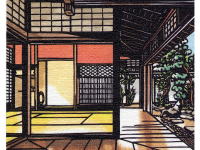富田林寺内町の探訪
I'm glad to intorduce an old town, Jinaimachi, Tondabayashi, Osaka, Japan as a national historic district and heritage site.
It takes 30 minutes from Osaka city to Tondabayashi station by Kintetsu railways. A 10-minutes walk will take you to the historic town.
ギャラリー
Historical Buildings, Jinaimachi town, tondabayashi, japan
| 【Tourist guide to Jinaimachi town, Tondabayashi, a historic district and heritage site of Japan,Historical buildings Page 2/3】 | |
| Private residences of old merchants’ families Sorted below in chronological order of major traditional buildings of Jinaimachi town |
|
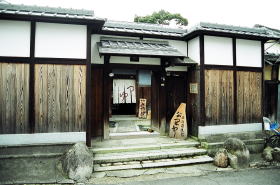 |
Residence of the Katsuma family OASI, Italian Cuisine Restaurant Open to the Public Year built: The later Edo period Location: at the intersection of Tomi-suji Street and (west) Hayashi-cho Street |
 |
Residence of the Kida family The interior is not open to the public. (Private residence) Year built: Location: |
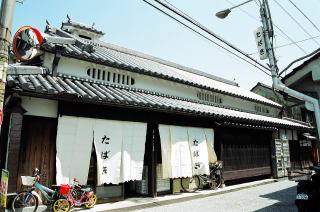 |
Residence of the Hashimoto family (Tabaki store) The interior is not open to the public. (Private residence) Year built: Location: |
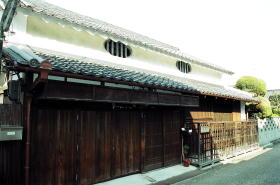 |
Residence of the Shimada family Jinaimachi Classico Open to the Public Open: Saturday and Sunday Year built: 1877 Location: |
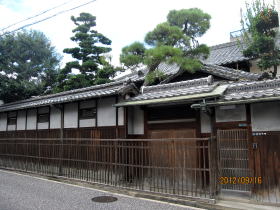 |
Residence of the Ishida family The interior is not open to the public. (Private residence) Year built: the early Meiji period Business: sake brewery Products brand name: Banri-no-Haru (business was discontinued.) Location: |
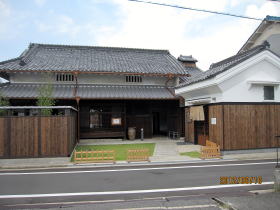 |
Former Residence of the Tanaka family Regisitered as a cultural property of the country Open to the Public Holiday: Monday Year built: 1892 Location: |
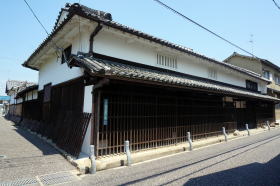 |
Residence of the Kitano family The interior is not open to the public. (Private residence) Year built: in the 1890's, the Meiji period Business: cotton wholesaler Trade name: Shindoya Location: |
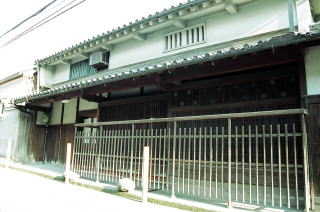 |
Residence of the Matsui family The interior is not open to the public. (Private residence) Year built: Location: |
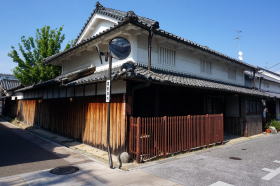 |
Residence of the Oda family The interior is not open to the public. (Private residence) Year built: The Meiji era Location: |
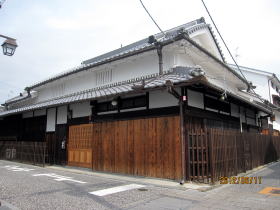 |
Residence of the Yamamoto family The interior is not open to the public. (Private residence) Year built: The Meiji era Location: |
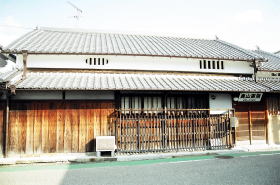 |
Residence of Okuyama family The interior is not open to the public. (Private residence) Year built: The Meiji era Location: |
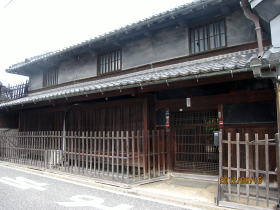 |
Residence of the Koshii family The interior is not open to the public. (Private residence) Year built: The late Meiji period Business: timber trader Trade name: Hiraoya Location: |
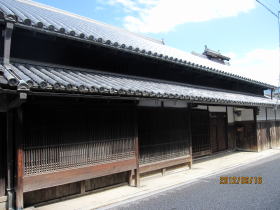 |
Residence of the(north)Koshii family The interior is not open to the public. (Private residence) Year built: Business: timber trader Trade name: Hiraoya Location: |
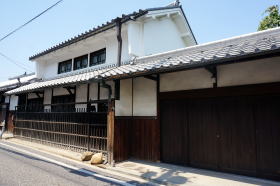 |
Residence of the Kuzuhara family The interior is not open to the public. (Private residence) Year built: Business: brewery of sake and mirin (sweet sake) Trade name: Totsukawaya Location: |
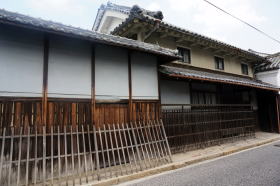 |
Residence of the Kitano family The interior is not open to the public. (Private residence) Year built: The Meiji era (?) Trade name: Shindoya Location: |
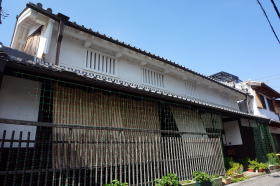 |
Residence of the Hashikawa family The interior is not open to the public. (Private residence) Year built: The early Meiji era (?) Location: |
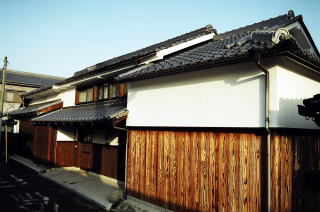 |
Residence of the Okada family The interior is not open to the public. (Private residence) Year built: The Meiji era Location: |
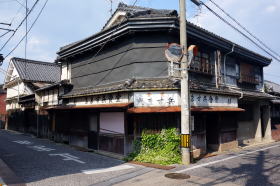 |
Residence of the Ishida family The interior is not open to the public. (Private residence) Year built: The Taisho period (1912-1926) Business: Japanese style restaurant (The business was discontinued around 1980.) Trade name: Higashi Masuhyo Location: |
 |
Residence of the Shibutani family The interior is not open to the public. (Private residence) Year built: The Taisho period (1912-1926) Business: furniture shop (The business was discontinued around 1980.) Trade name: Higashi Masuhyo Location: |
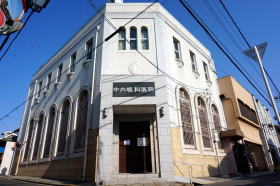 |
Nakauchi ophthalmic clinic A distingushed modern western style building registered as a cultural property of the country. Year built: The Taisho period (1912-1926) The building had been used as Tondabayashi branch office of ex.Sanwa Bank through the 1960'. Location: |
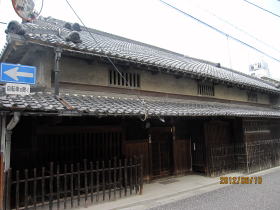 |
Residence of the (northewest)Okutani family The interior is not open to the public. (Private residence) Year built: Business: Timber trader Trade name: Iwaseya Location: |
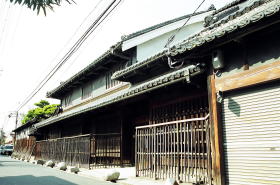 |
Residence of the Koshii family The interior is not open to the public. (Private residence) Year built: Business: Timber trader Trade name: Hiraoya Location: |
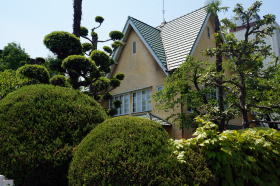 |
Residence of the Kuzuhara family A distingushed modern western style building The interior is not open to the public. (Private residence) Year built: Trade name: Totsukawaya Location: |
| The important preservation district for historic buildings in group of
the country The Jinaimachi historic district, which is a part of Tondabayashi-cho, Tondabayashi city in term of administrative area, has been selected by the country as one of important preservation districts for historic buildings in group since 1997. It has been solely designated in Osaka prefecture. Among approximately 500 buildings in the Jinaimachi town, 181 buidlings
which were built from Edo period to early Showa period has been identified
as traditional buildings. Advanced approval and authorization by the Cultural
Properties Protection Division of Board of Education, Tondabayashi Municipality
office has to be obtained when any changes of appearance of the status
quo including renovation, repair, remodeling, color, new construction and
demolish are planned within the preservation district. Through landscaping
works for preservation and restoration, historic district has kept the
old days' appearence of white wall, board fences, and lattice of quiet
rustic buildings where people are even now living as a place of life. |
|
| 【Tourist guide to Jinaimachi town, Tondabayashi, a historic district and heritage site of Japan,Historical buildings Page 1/3】 | |
| 【Tourist guide to Jinaimachi town, Tondabayashi, a historic district and heritage site of Japan,Historical buildings Page 3/3】 | |
Information

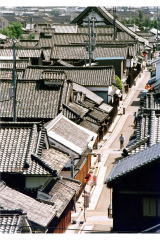
Jinaimachi in Tondabayashi(Jyounomon-suji street)
Photo: provided by Tondabayashi Municipality, unauthorized copying and
replication are strictly prohibited.
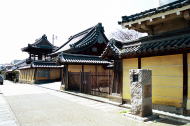
Koushouji Betsuin Temple (Tondabayashi Gobo)
Koushouji Betsuin Temple is a temple of Jodo Shinshu School (Ikkoushuu School), which became the center of the development and establishment of Jinaimachi town in Tondabayashi . It has been popular as Mr. Gobo (Tondabayashi Gobo) among the local residents.
During the Ouei period (1394-1412years) , the
The temple gate looks toward the east and the Jyounomon-suji street. Those buildings such as the bell tower, the drum tower, the main hall,
the reception hall and priest's quarters are set up and arranged.
The main gate has refined style and it became clear in a recent investigation
that the gate was further relocated from Koushouji temple in Kyoto, which
was originally said to be dismantled and reconstructed from one of the
gates at Fushimi castle in Kyoto.
Koushouji Betsuin Temple was designated as an important cultural property
of the country in 2014.
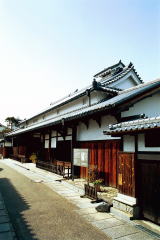
The former residence of the Sugiyama family, an important cultural property
of the country
Sugiyama family was one of the old family who was involved in the founding
of Jinaimachi town and the family flourished as a sake brewer throughout
the Edo period.
The former Sugiyama family residence is the oldest building among those
merchants’ houses in Jinaimachi and it is the remains of a large merchant
house of the mid-Edo period.
The residence is the birthplace of Ms. Tsuyuko Isonokami, a female poet
of Myojo school (Her autonym was Takako Sugiyama, 1882ー1959).
The property was designated as an important cultural property of the country
on October 26, 1983 as a typical architecture of merchant’s house which
was originated from farmer's house in Minami-Kawachi region.
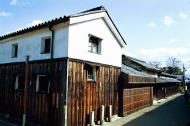
Residence of the Nakamura family, a cultural property of Osaka Prefecture.
Nakamura family is one of the old families in Jinaimachi in Tondabayashi.
The residence is located almost at the southern tip of the town. The family
used to do business as Sadoya and had identified himself as Tokubei since
1734. The founder of Tokuemon was said to be a descendant of the eight
headmen of exploitation of Tondabayashi.
Though the old family business was not clear, it made a significant development
as a sake brewery, after acquiring the brewing license in 1785. The amount
of sake production in 1785 reached 2,135 koku, the largest among breweries
in Kawachi region.
Remark:
1 koku is an old unit equivalent to 150kgs or 180 litter of rice for brewing,
which is corresponded to the assumed yearly consumption of rice per adult.
In 1792, Sadoya of the Nakamura family was promoted to be the chief director
of
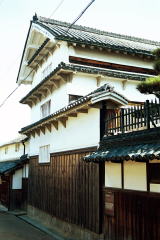
The three-story storehouse of the residence of the (south) Kuzuhara family
The family prospered to run sake brewery. Built in 1854, there are few
three-story earthen wall storehouses of wooden structure in Japan and it
is identified as a landmark of Jinaimachi town.
The building has eaves on each floor and the method of roofing is called
Hongawara-buki that plain tiles and concave tiles are alternately arrayed
on the roof.
The gable of the storehouse is directed to the street and its white walls
are distinguished. It was used for storage of straw rice bales for a payment
of rice as land tax in old Japan.
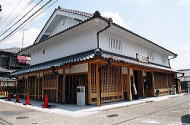
Visitor Center
(Jinaimachi Kouryuukan,
Town Community Center)
Address
9-29, Tondabayashi-cho, Tondabayashi city, Osaka, 584-0033, Japan
TEL.+81-(0)721-26-0110
FAX.+81-(0)721-26-0110
open 10a.m. until 5 p.m.
closed on Monday
Visitor Parking
Road width is very narrow in Jinaimachi town. If traveling by car, please
use Tondabayashi Municipal east parking newly opened in February 2014 (Toll
parking).
You can park the minibus for groups and passenger cars for general use.
Only one parking lot available for minibus, you must book it in advance
with Tondabayashi City Hall. A 15-minute walk to the Jinaimachi Visitor
Center and 5 minute walk up to the former Sugiyama family house, an important
national cultural property.
You will note that you will contact Tondabayashi Municipality Office for
a parking lot of large tourist bus for groups. Thank you in advance for
your kind cooperation.
